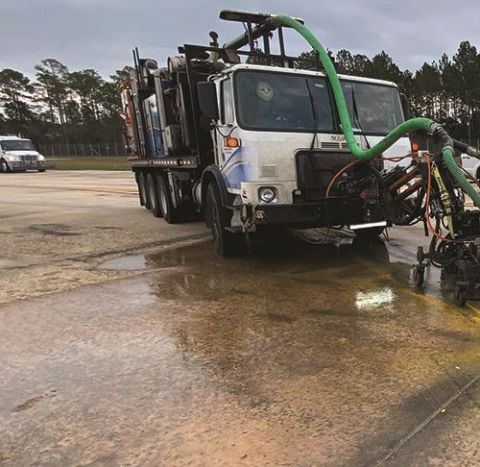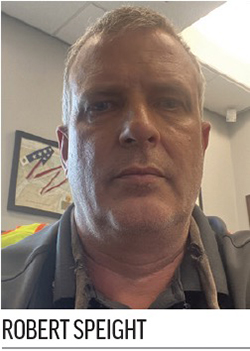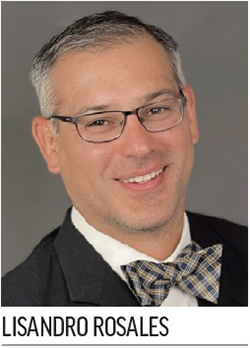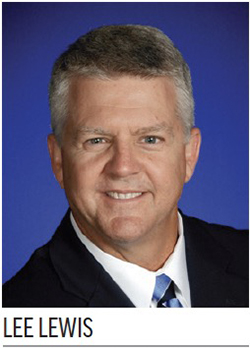Florida’s Statewide Markings Program Evolves

Between thunderstorms and blazing heat, there are plenty of obstacles that can complicate airfield maintenance in Florida.
 One thing that’s not a hurdle? Finding a reliable, cost-efficient team for airfield marking projects. That’s one mission of the Florida Department of Transportation (FDOT) Statewide Airfield Pavement Management Program. The initiative, which has existed for years in several iterations, is finding new success with a slightly different format. In 2020, the program contract was awarded to Florida Airfield Maintenance, a multifaceted joint venture that allows FDOT to offer airports a one-stop shop for airfield markings.
One thing that’s not a hurdle? Finding a reliable, cost-efficient team for airfield marking projects. That’s one mission of the Florida Department of Transportation (FDOT) Statewide Airfield Pavement Management Program. The initiative, which has existed for years in several iterations, is finding new success with a slightly different format. In 2020, the program contract was awarded to Florida Airfield Maintenance, a multifaceted joint venture that allows FDOT to offer airports a one-stop shop for airfield markings.
“It’s just a huge win,” says Robert W. Speight, senior manager of Airside Facilities at Jacksonville Aviation Authority. All four airports owned and operated by the Authority use the program, and Speight is enthusiastic about its results.
|
Project: Maintaining Airfield Markings Initiative: Statewide Airfield Pavement Management Program Sponsor/Administrator: FL Dept. of Transportation Participants: 95 public airports throughout FL, among 100+ that are eligible Sample Location: Jacksonville Int’l Airport Contractor Joint Venture: Florida Airfield Maintenance Markings Assessment: Sightline Inc. Cleaning & Removal: Danton Hydroblasting Application: Emerald Coast Striping; Roads & Runways Striping Service Inc. Quality Assurance: AVCON Inc. Key Benefits: Airports receive competitively procured rates for markings application & maintenance without having to bid their projects individually; condition assessments help minimize/prioritize the immediate work scope; airports of all sizes receive volume pricing; cleaning & application contractors have large reserves of equipment & labor; third-party quality assurance company verifies contractors’ work |
Florida Airfield Maintenance consists of four companies, each specializing in a different step of the airfield marking process. Sightline Inc. assesses existing markings to identify which need to be cleaned or replaced; Danton Hydroblasting powerwashes and/or removes those that don’t pass muster; Emerald Coast Striping and Roads & Runways Striping Service Inc. apply new markings.
“The reason we came up with this joint venture was [feedback about] previous contractors,” says Lisandro Rosales, the program manager at Florida Airfield Maintenance.
In the past, there had been recurring complaints from airports about crew availability and communication mishaps. That inspired Rosales to submit a program proposal that leveraged the power of strength in numbers. “We realized that as a single company, we just didn’t have the resources or the skillset to service all of Florida’s airports,” he explains. “But if we group together with people who specialize in [different services], we could form a strong company, or, in this case, joint venture.”
The resulting four-company team has been able to provide better service to Florida airports, and more airports are participating in the state program, Rosales reports. Built-in efficiencies and a collaborative mindset save program participants a lot of time and hundreds of thousands of dollars,
he adds.
Building Something Better
The program supports airports throughout the state in a variety of ways.
For starters, Florida Airfield Maintenance offers competitively procured rates for markings application and maintenance services. “Each airport doesn’t have to go out to bid and find a qualified, maybe low-bid, contractor to do the work,” explains Mike Speidel, vice president at Sightline Inc. “That’s all done for them,”
Typically, the procurement process can take an airport weeks and cost thousands of dollars, he adds.
Next, the program offers condition assessments. If an airport doesn’t have internal staff to gauge the condition of its markings, Sightline can visit its airfield, test reflectivity and other crucial factors, and develop an appropriate scope of work. This helps prevent a common knee-jerk assumption that every marking on an airfield needs to be repainted at the same time. “One of my primary goals when our teams are collecting data and assessing is to identify savings, meaning find markings that are in good enough condition to last,” Speidel explains. In short, sometimes markings just need to be cleaned, not repainted. “My teams go in and identify what does not need any more maintenance, which saves time and money and gains efficiencies,” adds Speidel.

At Jacksonville International Airport (JAX), Speight uses condition assessments from Sightline to plan and budget future projects. “We use it with our own data and figure out what we need to prioritize—what needs to be done immediately, what needs to be done in the short-to-medium term, and what can be held off and done in the long-term. That helps me offset my workload,” he explains.
According to Speidel, prioritizing projects correctly has identified $225,000 in savings per assessment. “The surprising thing is just how much money we’ve been able to save [program participants],” he remarks. “When your assessment costs a small fraction of the savings, that’s a pretty good ROI.”
 Condition assessments help JAX determine which smaller projects to tackle as needed over time, rather than repainting all markings at once. “I think what Jacksonville reflects is the strength of this project because they use all facets of the program,” says Rosales. “They use every piece of it depending on what their needs are. That’s trickled over to the other airfields that are under the Jacksonville Aviation Authority umbrella. So now the other airfields [Jacksonville Executive at Craig Airport, Cecil Airport and Herlong Recreational Airport] are starting to use all their services like that, and they’re seeing a benefit,” Rosales says. “They’re doing small, manageable maintenance projects on a more timely manner and it’s costing them a lot less.”
Condition assessments help JAX determine which smaller projects to tackle as needed over time, rather than repainting all markings at once. “I think what Jacksonville reflects is the strength of this project because they use all facets of the program,” says Rosales. “They use every piece of it depending on what their needs are. That’s trickled over to the other airfields that are under the Jacksonville Aviation Authority umbrella. So now the other airfields [Jacksonville Executive at Craig Airport, Cecil Airport and Herlong Recreational Airport] are starting to use all their services like that, and they’re seeing a benefit,” Rosales says. “They’re doing small, manageable maintenance projects on a more timely manner and it’s costing them a lot less.”
After an assessment is complete, Florida Airfield Maintenance provides the labor and equipment to get the job done. “They have a paint crew, they’re professional, and they’re great,” Speight reports. “They come in and do all of our big painting.”
He estimates that if JAX had completed a recent markings project in-house, the work would have required eight to 10 days of runway closures. But it only took one day, because Florida Airfield Maintenance has more equipment and capabilities. “That saves time and money, and saves impact on the FAA tower and the airlines,” he adds.
 Finally, the statewide program provides third-party quality control by AVCON Inc., a company outside the joint venture. Lee Lewis, an AVCON vice president, built upon previous contracts by clarifying several aspects of the program’s scope and better defining the role of independent quality assurance. “The program is really intended to re-mark existing airfield pavement markings, not to engineer new markings,” Lewis explains. “Our team is independently measuring tolerances and ensuring quality control processes per FAA P-620 technical standards, not necessarily checking whether the existing markings are in compliance with the marking advisory circulars.”
Finally, the statewide program provides third-party quality control by AVCON Inc., a company outside the joint venture. Lee Lewis, an AVCON vice president, built upon previous contracts by clarifying several aspects of the program’s scope and better defining the role of independent quality assurance. “The program is really intended to re-mark existing airfield pavement markings, not to engineer new markings,” Lewis explains. “Our team is independently measuring tolerances and ensuring quality control processes per FAA P-620 technical standards, not necessarily checking whether the existing markings are in compliance with the marking advisory circulars.”
Before a project begins, AVCON is deliberate in asking an airport to confirm that, to its knowledge, the markings are in the correct locations. “In the field, we’re looking at accurate application rates, proper calibration of reflective media, as well as line widths and spacing within tolerances. But for the most part, we’re not engineering or surveying locations for the markings,” Lewis says. That part of the process remains the airport’s responsibility. “Of course, if we see something in the field that appears off or doesn’t look right…everyone stops and the airport is given the opportunity to provide direction. That is one of the benefits of having firms involved who are familiar with airfields. It greatly reduces the risk of re-marking something out of compliance.’”
Lewis explains to program participants that he attends their project meetings and dispatches objective airfield inspection crews to protect their interest. “We are independently certifying whether the contractor did what they were supposed to do,” he summarizes. “There is better accountability with this process, so airports are consistently happy with the results.” This adds a layer of consistency and effectiveness that improves on previous contracts for the program.
A Wide Range of Budgets
One thing is clear: This approach can save airports money. The exact costs (and savings) each airport can expect aren’t as clear, since no two airports have the same needs.
Because the program contract is available to all 100+ public airfields in Florida, participants benefit from volume pricing—a particular boon for smaller airports. Condition assessments help keep the work scopes as small as possible, and quality assurance checks help verify that airports are getting what they pay for; but prices vary greatly according to the specific work each airport needs.
 From Speidel’s perspective, the FDOT Statewide Airfield Pavement Management Program serves a public accountability function. “Some of our airports ask for state funds,” he explains. “So to be good stewards of those taxpayer dollars, we want to make sure that number one, the airports need what they’re asking for. That’s where the condition assessment can come in. And number two is the quality control side…making sure that we’re doing well by Florida taxpayers and the airports, too.”
From Speidel’s perspective, the FDOT Statewide Airfield Pavement Management Program serves a public accountability function. “Some of our airports ask for state funds,” he explains. “So to be good stewards of those taxpayer dollars, we want to make sure that number one, the airports need what they’re asking for. That’s where the condition assessment can come in. And number two is the quality control side…making sure that we’re doing well by Florida taxpayers and the airports, too.”
One “downside” to keep in mind? As word about the program continues to spread, demand for services by the joint venture of contractors is increasing. To date, about 95 public airports participate in the program.
“The most challenging thing is…people [are realizing] how good of a deal it is,” Speight says. “If you’re not planning six to nine months in advance, you’re behind the power curve…but that’s due to the success of people wanting the contract.”
As the program grows throughout the state, so do the savings for airports.
2022 Charlotte Douglas International Airport Report of Achievement
 Giving back to the community is central to what Charlotte Douglas International Airport and its operator, the City of Charlotte Aviation Department, is about, and last year was no different.
Giving back to the community is central to what Charlotte Douglas International Airport and its operator, the City of Charlotte Aviation Department, is about, and last year was no different.
Throughout 2022, while recovering from the COVID-19 pandemic, we continued our efforts to have a positive impact on the Charlotte community. Of particular note, we spent the year sharing stories of how Connections Don't Just Happen at the Terminal - from creating homeownership and employment opportunities to supporting economic growth through small-business development and offering outreach programs to help residents understand the Airport better.
This whitepaper highlights the construction projects, initiatives, programs and events that validate Charlotte Douglas as a premier airport.
Download the whitepaper: 2022 Charlotte Douglas International Airport Report of Achievement.
 facts&figures
facts&figures








